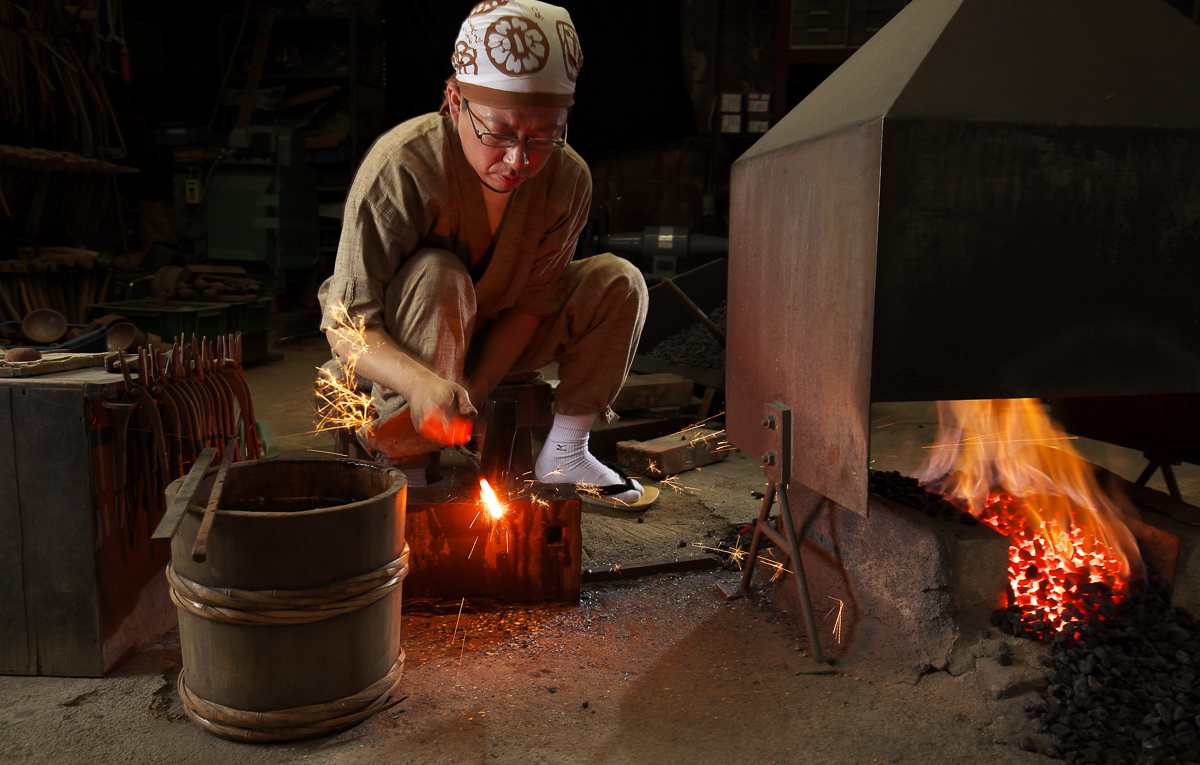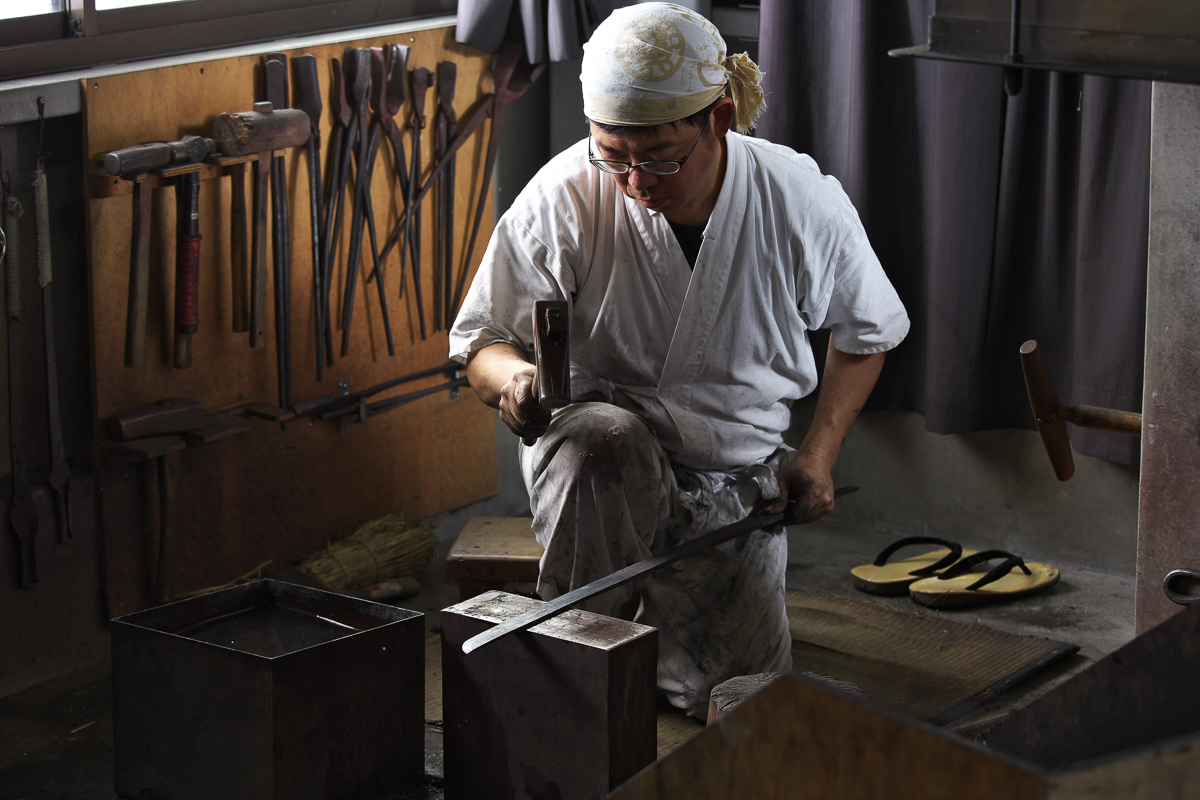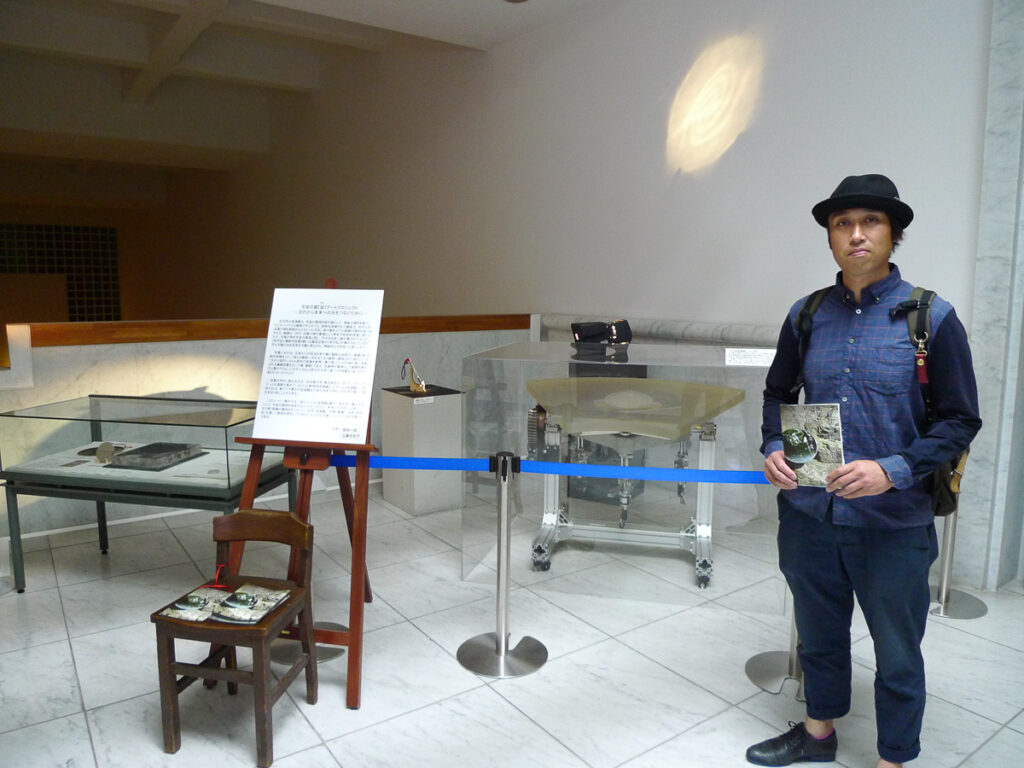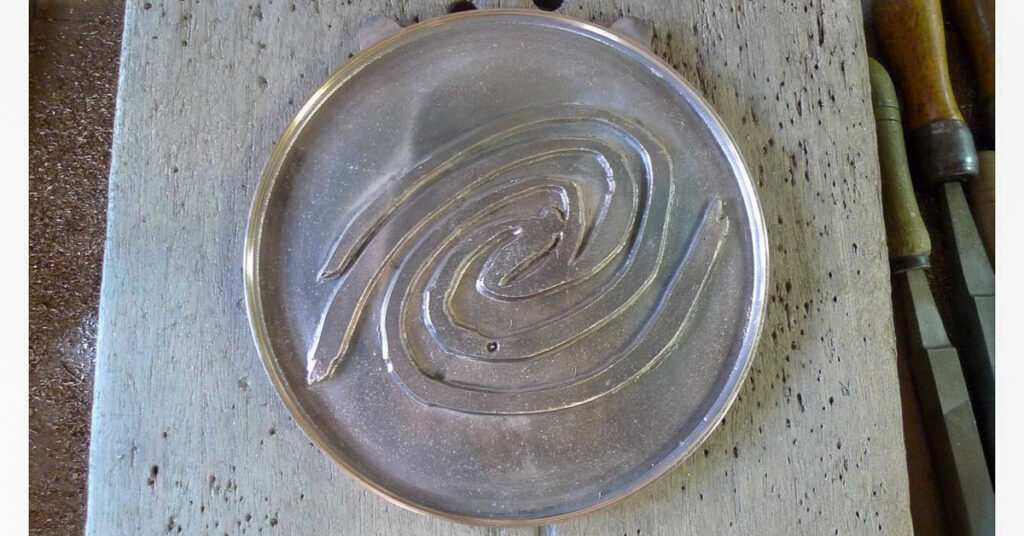Sachiko Tamashige writes about two Japanese metalsmith families, Myochin and Yamamoto, who demonstrate an alchemical power to transport base metal into the spiritual realm.
I chose two families of Japanese handicraftsmen, The Myochin family as blacksmiths (forging and polishing) and the Yamamoto family as mirror makers (casting and polishing ), to introduce the power of craftsmanship to transform physical material into something beyond with special spiritual power. Those things can be used as regalia or talisman.
There are three items of Japanese Imperial regalias essential to ascend to the throne of the emperor: “mirror”, “sword” and “comma-shaped bead (jewel of jade)”. I chose two of them, “mirror” and “sword” to argue the power of things that are made by accomplished craftsmen. This might be the area in which human-being can retain its raison d’etre, to survive the coming era of the domination of robots and Artificial Intelligence.
It is time that we can look at the traditional craft to enhance the ability of human-being, making things by hand and find a way to co-exist with those highly intelligent robots or machines.
Myochin family
Tamahagane is a special form of purified steel in the traditional method by using bellows, limited to be used by swordsmiths.
The moving image from the installation of the exhibition at the Himeji City Museum of Art / courtesy of the Himeji City Museum of Art
A clear sound resonates when the fire chopsticks touch. It is said this enigmatic trailing sound is emitted only from forged iron. The skills of heating and forging this iron are skills kept secret and passed down through the generations of this one family.
Myochin family is a lineage of armour makers of 53 generations over 850 years, evolving with the times. The present Myochin family is based in Himeji of Hyogo prefecture, are Munemichi (79 years old, father), the third son Munetaka (45 years old). The 53rd family head of the Myochin is a blacksmith and the second son Munehiro (47years old) is a swordsmith (the first generation of Myochin as swordsmith).
The Myochin is an old well-known family of craftsmen with a unique forging technique, that has been passed on since the Heian Period (794-1185). The family dates back to the twelfth century and their business originated from armour, which has been used by aristocrats like the emperors as well as the major clans of Samurai warriors. It is said that the emperor Konoe (1142-1155) commissioned the family to make a suit of armour. The emperor was pleased by their work and praised their armour for its excellence, particularly mentioning that it is such a rare armour that makes a sonorous, bright and clear sound and gave them the brand name “Myochin” (“bright” and “rare”)
The brand name “Myochin” has been spread across the country with the reputation of brilliant forging skill. Many Daimyo, feudal lords, used their armours. During the Edo period, the Myochin was employed by the Sakai family, the lord of Himeji, so that they came to Himeji with the Sakai family from Gunma prefecture.
It was written in an old manuscript in Himeji that armours by Myochin were so strong that they had never been cut or penetrated by swords or guns. After the end of the Edo period, the era of Samurai was over and then when the Meiji era started, armourers lost jobs as well as swordsmiths.
Muneyuki, the 48th head of the Myochin family, started making Hibashi, metal fire chopsticks, which was normally used for handling charcoals at a brazier. The Myochin Hibashi became popular particularly among people of the tea ceremony. The Myochin family shifted their business successfully from the armourer to the blacksmith by making Hibashi and Jizaiokimono (metalwork), etc.
But then they have to confront a few more crises. During World War II, the materials of their products such as steel and iron had to be delivered to the army and after the war, their private property of the family, all armours and swords which had been passed on from their ancestors were confiscated according to the GHQ’s order. They manage to survive by selling their house and land so that they can keep making Myochin Hibashi as blacksmith. But the lifestyle of Japanese people after World War II had modernized rapidly and as for the heating system, the charcoal brazier or the fireplace had been replaced with oil, gas stove or electric heater. The demand for Hibachi was shrinking.
Munemichi, 52nd family head (father), had to go through a hard time and thought of making wind chimes by using the skill of Hibashi (metal fire chopsticks). By trial and error, he succeeded in completing Hibashi Furin, a wind chime in Hibashi shape, which sounds so incredibly beautiful that they became well-known souvenirs and specialties in Himeji. In fact, the quality of sound has been highly appreciated by prestigious musicians, sound experts such as the late Isao Tomita, one of the most important composers who pioneered electric music using synthesizers. Tomita made it his signature tune, which was used for the opening ceremony of the Tokyo Olympics. Tomita entertained his friends from overseas such as Stevie Wonder with the sound of Myochin Hibashi and Japanese sake. Stevie Wonder praised its sound by calling it “the Enigma of the East”.
Since 1964, the timbre of Myochin Fire Chopsticks has been used to test the sound quality of SONY microphones. Myochin also collaborated with the watch and clock manufacturer SEIKO to make a special sound for their products.
Munemichi is nearly 80 years old. The head of the family decided to let his son Munetaka succeed to Myochin’s name as the head of the family 53rd generation, in May 2021.
Although Munehiro is the second son, he had decided to start a new school of swordsmiths instead of succeeding to the Myochins as a blacksmith. Although Munehiro set up his own studio of sword making, he sometimes collaborates with his brother by forging Tamahagane steel which is a special form of purified steel and is allowed to use for sword making.
Munehiro makes stratified Tamahagane steel with more than 30,000 layers by forging for his sword. He put a lump of steel (in a square) into the fire, which he folded and hammered countless times. This process made Tamahagane a very special substance. Then Munetaka, younger brother, takes over to shape Tamahagane into fire chopsticks wind chime. When I visited the studio of Munetaka, he demonstrated how to make Myochin Hibashi of iron (instead of Tamahagane) by forging. I was amazed by the speed and the degree of concentration of Munetaka, shaping the cylinder-shaped iron sticks into chopsticks. He said he could make the shape of Hibashi easily but it is so difficult to make it sound properly. You need a kind of leap to transform metal chopsticks into metal chopstick wind chimes with formless value as superb sound.
The power of the sound of Myochin products
The moving image from Sankei News
When a pair of chopsticks touch each other, it creates an amazing heavenly sound as if it transported one’s mind to space or another dimension.
One blacksmith Mitsuo Amitori who makes Nambu Tetsubin of iron in Iwate showed me a pair of iron chopsticks touching each other and demonstrated how it sounded. It only made a dull sound, although their iron chopsticks themselves are excellent as fire chopsticks. Mr Amitori said, “Myochin Hibashi is just superbly special although I am proud of my own product.”
Yoshihiro Kanno, an eminent composer who has been using the Myochin Hibashi Furin, the wind chime, for his tune and his inspiring art installation work, said “The secret of the special sound and its resonance of Myochin Hibashi is not explained, yet.” He found the 70 KHz or higher from Myochin Hibashi Furin, although the limit of the metal instruments called Orin, a Buddhist bell is about 40KHz-50KHz. Considering the limit of an audible sound is between 2KHz and 20KHz, the sound of Myochin Hibashi might touch upon something beyond more than the auditory sense.
Another remarkable topic of the Myochin family is that Myochin Munetaka (Keizo), the 53rd generation of the Myochin family gave a special lecture and held a forging workshop for Metallurgy education, at MIT, The Massachusetts Institute of Technology to introduce the history of the Myochin family and their distinctive manufacturing method. More than 100 students and researchers at MIT participated. Many students felt that the craftsmanship with handmade can be still very important in the age of automation with AI and 3d-printer.
Munehiro’s sword
The three points to appreciate sword as art are sugata(shape), jigane (the steel patterns) and hamon (the temper patterns ), which is the distinctive tempered patterning along the cutting edge of the sword’s blade, central to the sword’s aesthetic beauty. Hamon include suguha, straight pattern, undulating wave-like notare and clove shaped choji. The hamon of a work of Munehiro reflects his sensibility and personality. He got his image of hamon inspired by the clouds of the sky in summer, which is a projection of his mindscape.
Let me quote some sentences from my article in 2018.
“Although swords are weapons originally, Japanese swords, with perfect clarity and beauty, became to be treated as talismans to ward off evil spirits. Japanese swords are a quintessential example to explain the national characteristics of Japan, including its aesthetics, mentality and skills and attitude that support the manufacturing of sophisticated fine arts and crafts.
“The deep shine of Japanese swords is achieved by skilful polishing. But this polishing is done by a collective team. Therefore, polishing techniques have been highly developed together with the techniques in making swords.
“When one encounters the breathtaking beauty and clarity of the gleaming surface of Japanese swords, one cannot help feeling clear, up-lifted and sublime.”
I think that sword has magic light that can activate our body to be pure, honest and brave so that our gods will guard and cherish us. Myochin Hibashi also has a magic power of sound that transcends one’s mind. Now, remember the origin of their name, Myochin, given by Emperor Konoe, who highly appreciated the sound from a suit of armour. The Myochin family have survived by reinventing themselves and adapting their business to the demand of the time. But the Myochins have passed on their DNA of the amazing quality of sound and light of metalsmith over eight centuries to the present day.
The skill to forge the armour that once protected the lives of samurai now resonate in a sound quality that enlivens and inspires the soul by connecting with the secret of the universe.
Yamamoto family
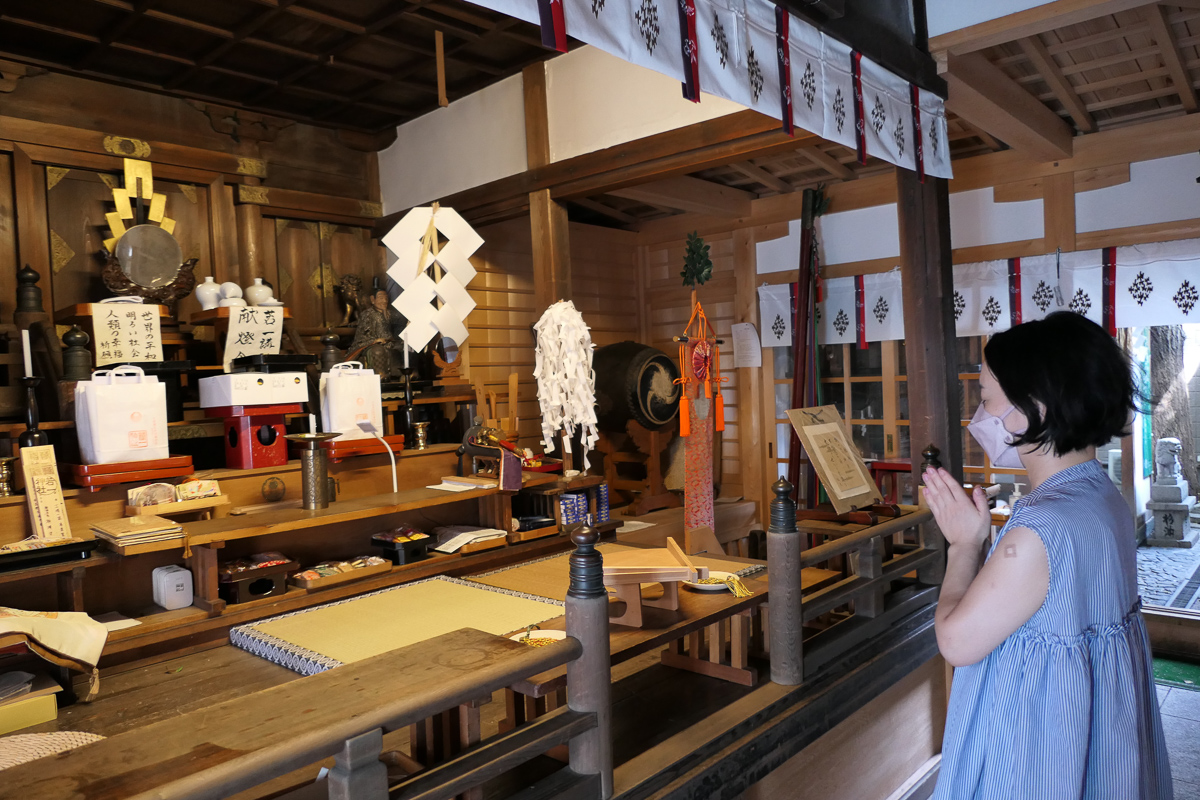
The altar of the shrine of Nyakuichi Jinnjya in Kyoto, with the mirror polished by Yamamoto Akihisa, a Japanese bronze mirror maker. A lady prays facing the reflection of herself on the mirror, by checking whether her soul is honest, pure and clear enough to see kami, or god, believing that one soul is part of kami, the entire universe. Photo: Sachiko Tamashige
Ancient Japanese people sensed gods and spirits in nature such as rocks, waterfalls and trees and they worshipped each of them. The sun is particularly important as it is the source of light that enables all creatures to live and grow. At the archeological site in Okinoshima, fragments of mirrors were discovered on the top of the rock. It shows that the ancient people created the altar by putting mirrors to bring down the light of the sun to the rock. This must have been the form of worshipping the sun before they invented the personalized gods like Amaterasu, the sun goddess, the ancestor of the imperial family of Japan.
Bronze mirrors became popular and were produced in large quantities during the Han Dynasty and the use of bronze mirrors became widespread in China. So the ancient craft of mirror-making spread to neighbouring Korea and Japan. Bronze mirrors came to Japan from the continent in the Yayoi period (date from 300BC to 300AD) and they had been developed in Japan’s own way. In ancient Japan, bronze mirrors were especially revered as rare and amazing so that they overwhelmed people with their magical power. They were high-tech objects of the time, which radiated a beam of the sunlight, therefore, the rulers of the time used them for their rituals to ensure their authority. Bronze mirrors became to have close ties to religious rituals. They played a key role as a host to the gods. Subsequently, the mirror became sacred and the specific mirror Yata-no-Kagami became one of Japan’s imperial regalia. It is believed that Amaterasu resides in the Yata-no-Kagami, housed in Ise Shrine in Mie Prefecture.
Yamamoto Akihisa (handcrafted bronze mirror maker) was born in 1975 as a fifth generation of mirror maker from Yamamoto Metal Works, founded at the end of the EDO period. He joined his family company after graduating from Ryukoku University, at which he studied Buddhism in the literature department, as part of Yamamoto Metal Works which deals with bronze mirrors and the ornaments for Buddhist altars. Yamamoto Metal Works is now the only producer of handcrafted Japanese mirrors, sacred mirrors, and magic mirrors in Kyoto. Akihisa is involved in the production of mirrors for Shinto shrines used as sacred hosts or offerings and the restoration of mirrors in the treasure house of shrines and museum collections.
A finished bronze mirror has a smooth and shining front surface and its backside is decorated with patterns. The design on the back of the mirror is first drawn on paper and then applied to a mould of sand by pressing with carving tools. Over 200 different carving tools are used to form designs in the sand mould for the back of the mirror. The designs feature sacred beasts or flowers or plants imprinted in the sand. A mould can take several months to create, according to the size of the mirror and the complexity of the design. Then the cast is filled with molten metal.
Once a bronze mirror is cast, it is ground and polished repeatedly. The tools to grind a mirror are metal files of differing roughness used and a steel tool called sen with handles on both sides. Sen is particularly used for grinding to make the mirror’s surface smooth. Polishing with whetstones and charcoal, the surface of the rough metal gradually turns into a shiny mirror surface. A mirror maker does grinding while sitting cross-legged.
Magic mirror (makyo)
Some bronze mirrors are known as magic mirrors, or makyo. One side is brightly polished, while an embossed design decorates the reverse side. When light is directed onto the face of the mirror and reflected its flat surface, an image featured on its back magically appears.
Yamamoto Shinji, or Oryu, the third generation, grandfather of Akihisa found the method to create Christian magic mirrors in 1974. The term “magic mirror” refers to a mirror that projects the design applied to its back in its reflected light. In Japan, they began appearing in historical documents around the middle of the Edo period. In particular, the Christian magic mirrors were used by Christians who endured persecution for their forbidden faith under the regime of the Edo period. At first glance, they look like normal mirrors but when it is exposed to a strong light, they project images such as Christ on the cross or Virgin Mary in the reflection, so that they could be used for hidden worship.
The principle of the phenomena of magic mirrors is the following process. When metal mirrors wear down from repeated grinding and polishing, they can sometimes project the embossed design on the back, as the uneven mirror surface is exposed to the light and reflected by caching the patterns of the backside. The old, re-polished mirrors can sometimes display the magic mirror phenomenon, accidentally.
We call traditional hand-craft bronze mirrors wakagami, or Japanese mirrors. There used to be more than 100 wakagami makers in Kyoto but wakagami has been gradually replaced with mirrors using glass since the Meiji era. Today common Japanese do not use wakagami any longer and bronze mirrors are not necessary for everyday life. Although there had been enough commission works to sustain his family business, Akihisa has been thinking about the significance of continuing to make bronze mirrors with handcrafting as a craftsman in the modern age.
He often was asked by people why he does not make the mirrors with machines. He answered by saying that’s because the techniques of handcrafting are still necessary. If he is only making new mirrors, he might be able to do that with machines, but restoration and refinishing is an unavoidable part of working with bronze mirrors in his business. “We can’t restore an old mirror without the skill to make a mirror from scratch by hand. We also have to make replicas of bronze mirrors from museum collections. Once handicraft skills are lost to mechanization, it is difficult to regain them.” said Akihisa.
Unlike many traditional craftsmen, Akihisa grew up without any pressure to inherit his family business. It seems very natural and spontaneous that he got involved in it when he began helping with his father’s work to earn some pocket money and then it gradually led him to genuine enjoyment.
He started his work in the company by making cast metal implements used for Buddhist worship. He had to repeat the same motions over and over, but he felt it was enjoyable. After years of doing basic foundation work in the family business, his grandfather started letting Akihisa learn to make mirrors.
One can expect that the training to become a craftsman in a traditional family is extremely strict. But it wasn’t in his case. Whenever Akihisa asked a question, his grandfather answered, and he never got angry with him. Akihisa had three wonderful mentors: his grandfather, great-uncle, and father. All made mirrors so that it enabled Akihisa to observe, draw on skills and knowledge from each of them. Akihisa said that he got a very fortunate start as a craftsman.
His great-uncle Hachiro gave a big influence on Akihisa by working closely with Akihisa while his grandfather Shinji provided instruction on the key points. Akihisa’s father, Fujio, taught him the management of the business by attracting his attention to expenses and deadlines.
Art project The mirror of the universe—Sora
- Completed mirror; photo: Sachiko Tamashige
- Akihisa with the projection of magic mirror
- Polished mirror with the Galaxy image
In 2014, I, Sachiko Tamashige, asked Akihisa to make a magic mirror with a pattern of the galaxy instead of the religious motif for the exhibition at the Museum of Kyoto University. It was part of the major exhibition to introduce the history of the astronomy of Kyoto University and its observatory “Kwasan Observatory”.
The former head of the observatory, Kazunari Shibata, in 2014 asked me to promote the new telescope “SEIMEI” in Okayama, which they have been developing by using the most advanced high technology method provided by the company in Gifu. Gifu is a region that has a long tradition of sword making. This company had developed a special technique of grinding high tech mirrors for the telescope. I wanted to bridge between the cosmology of astronomy and that of ancient Shintoism by juxtaposing a fragment of mirror from the new telescope and the traditional magic bronze mirror with the pattern of the galaxy created by Akihisa. I believe that any kind of mirror always has been reflecting the truth of the universe.
The moving image from the KSB news
I initiated this plan so that a traditional craftsman with superb skill could get in touch with the scientists like astronomers to find the new horizon of monozukuri, or making things. I also wanted to pay homage to Kaname Nakamura, who is the legendary mirror polisher for the telescope as well as an amateur astronomer and contributed to making “Kwasan Observatory” a sacred place for amateur astronomers.
Sachiko Tamashige
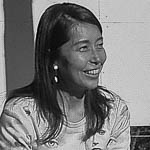 Sachiko Tamashige is a Japanese freelance journalist based in Kyoto, she has been working for various media such as broadcasting companies such as BBC, NHK, as well as the newspapers such as Japan Times, Asahi Shinbun and female magazines etc. specialising in cultures such as architecture, design and art. The style of writing is to put any kind of theme of culture in a social-historical context. If you would like to read any of Tamashige’s article in English, google Sachiko Tamashige, Japan Times, such as Seeing where Shinto and Buddhism cross.
Sachiko Tamashige is a Japanese freelance journalist based in Kyoto, she has been working for various media such as broadcasting companies such as BBC, NHK, as well as the newspapers such as Japan Times, Asahi Shinbun and female magazines etc. specialising in cultures such as architecture, design and art. The style of writing is to put any kind of theme of culture in a social-historical context. If you would like to read any of Tamashige’s article in English, google Sachiko Tamashige, Japan Times, such as Seeing where Shinto and Buddhism cross.

